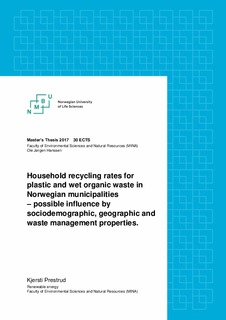| dc.contributor.advisor | Hanssen, Ole Jørgen | |
| dc.contributor.author | Prestrud, Kjersti | |
| dc.coverage.spatial | Norway | nb_NO |
| dc.date.accessioned | 2018-09-30T12:27:16Z | |
| dc.date.available | 2018-09-30T12:27:16Z | |
| dc.date.issued | 2017 | |
| dc.identifier.uri | http://hdl.handle.net/11250/2565308 | |
| dc.description.abstract | With population growth and a huge increase in consumption over the last decades, waste has transitioned from being considered a problem to being considered a resource. To exploit this resource in the most efficient way possible, household recycling of plastic and wet organic waste plays an important role. There is still potential to increase recycling rates for both these waste fractions.
The main hypothesis of the study is as follows: Norwegian households’ recycling rates of plastic and wet organic waste are expected to vary with differences in sociodemographic, geographic and waste management variables between the municipalities.
The study uses data collected from Statistics Norway’s KOSTRA database. Stepwise multiple regression analyses were performed to analyze if there is a correlation between the different variables and the recycling rates for both waste fractions. The results indicate that some properties, such as the share of the population sent to recycling facilities, unemployment rate and the share of the population living in detached houses, correlate with the recycling rates. However, the goodness of fit of the models were quite low, and the properties only partly explain the variance in the recycling rates between municipalities.
Through the use of chi-square tests and t-tests it was found that some of the variables characterize the municipalities with the highest and lowest recycling rates, geographical region and annual number of collection days for wet organic waste. Chi-square tests were also applied for the annual waste management fee, and the most important result is that the relationship between a high fee and a high recycling rate is not an instinctive relation.
The results of the study can be used by local and national waste authorities, waste management companies and environmental organisations working with waste, to better adjust the recycling systems to the households’ performance and requests. Understanding how the factors influences the rate, can help to find ways of increasing it. | nb_NO |
| dc.description.abstract | Over de siste tiårene, med befolkningsvekst og en stor økning i forbruket, har vi endret hvordan vi håndterer og betrakter avfall. Vi har gått fra å anse avfall som et problem til å anse det som en nyttig ressurs. For å kunne utnytte disse ressursene på den mest mulig effektiv måte, spiller kildesortering av plast og våtorganisk avfall i husholdninger en viktig rolle. Det er ennå store forskjeller i husholdningers kildesorteringsgrad mellom norske kommuner, og det er usikkerhet knyttet til hvorfor disse forskjellene eksisterer.
Hypotesen for studiet er som følger: Norske husholdningers kildesorteringsgrad for plast og våtorganisk avfall er forventet å variere med forskjeller i sosiodemografiske, geografiske og avfallstilknyttede variabler mellom norske kommuner.
Studiet tar i bruk data innsamlet fra Statistisk Sentralbyrås KOSTRA-database. Stegvise multiregresjonsanalyser ble gjennomført for å analysere om det var en sammenheng mellom de forskjellige variablene og resirkuleringsgraden for begge avfallsfraksjoner. Resultatene indikerer at noen av variablene, blant annet andel avfall sendt til materialgjenvinning, arbeidsledighet og andel av befolkningen som bor i eneboliger, korrelerer med kildesorteringsgradene. Modellen har imidlertid lav forklaringsstyrke og variablene forklarer derfor lite av variansen i grad av kildesortering mellom ulike kommuner.
Ved bruk av kji-kvadrattester og t-tester ble det også funnet at noen variabler, deriblant geografisk område og antall hentedager for våtorganisk avfall, kjennetegner de kommunene med høyeste og laveste kildesorteringsgrader. Kji-kvadrattester ble også utført for det årlige renovasjonsgebyret, og det viktigste funnet fra disse analysene var at sammenhengen mellom høyt gebyr og høy kildesorteringsgrad ikke er en selvfølgelig sammenheng.
Resultatene av studien kan brukes av nasjonale og lokale myndigheter, renovasjonsselskaper og miljøorganisasjoner som jobber med avfall, for å bedre tilpasse kildesorteringssystemene til husholdningenes behov og kildesorteringsinnsats. | nb_NO |
| dc.language.iso | eng | nb_NO |
| dc.publisher | Norwegian University of Life Sciences, Ås | nb_NO |
| dc.rights | Attribution-NonCommercial-NoDerivatives 4.0 Internasjonal | * |
| dc.rights.uri | http://creativecommons.org/licenses/by-nc-nd/4.0/deed.no | * |
| dc.title | Household recycling rates for plastic and wet organic waste in Norwegian municipalities : possible influence by sociodemographic, geographic and waste management properties | nb_NO |
| dc.type | Master thesis | nb_NO |
| dc.source.pagenumber | 71 | nb_NO |
| dc.description.localcode | M-FORNY | nb_NO |

